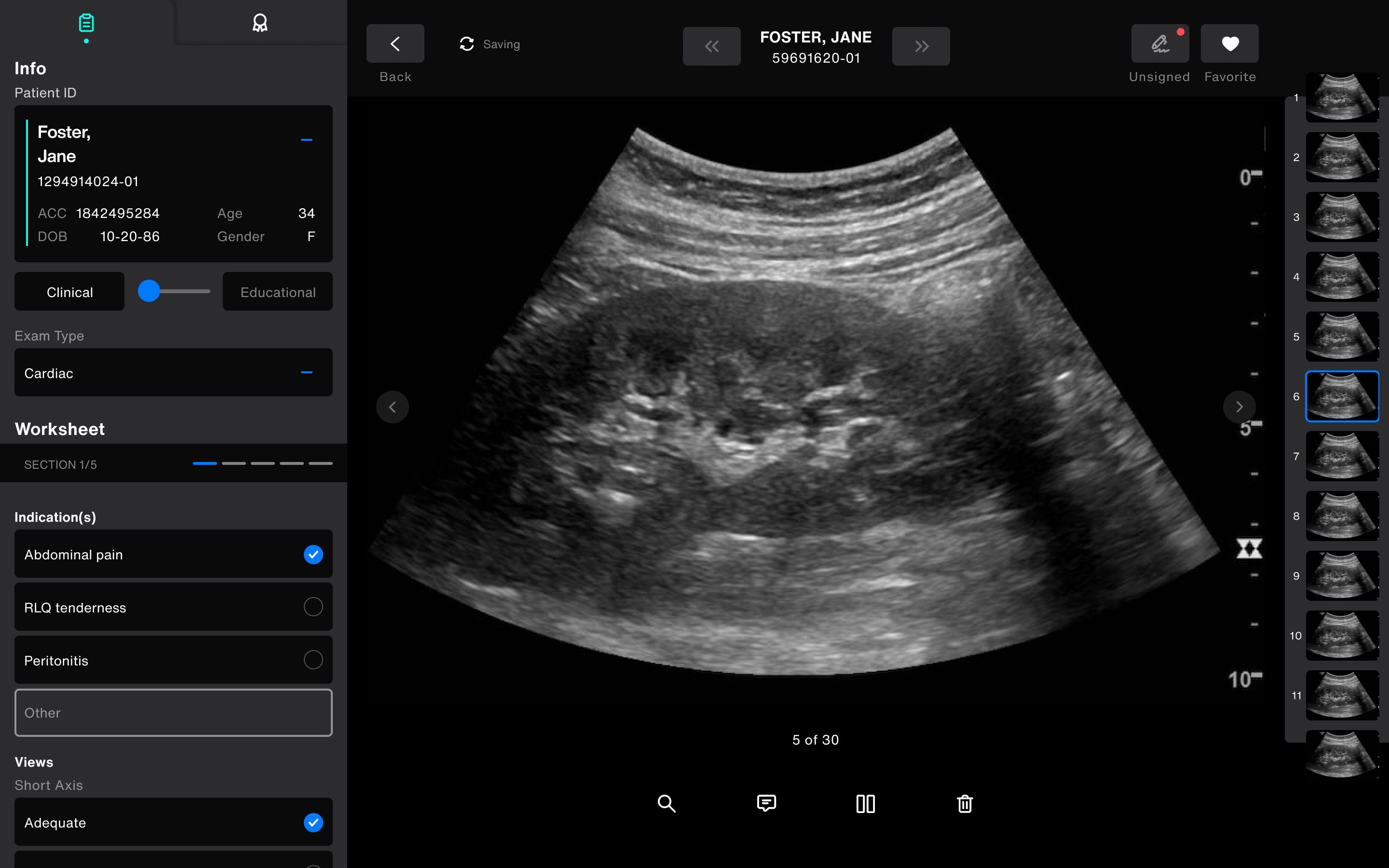What is POCUS in Radiology?
Category
Blog
Date
July 28, 2021
Source
Exo

Point-of-care ultrasound (POCUS) is the latest innovation in healthcare. With a point-of-care ultrasound machine, a broader spectrum of clinicians and caregivers have access to employ imaging at the bedside and beyond. But as this technology advances and becomes more common, radiologists have questions about how this opportunity informs and supports their own practice. Exo is here to unpack POCUS meaning for the medical field and how radiologists will also experience positive transformation as historic barriers to best practices are eliminated.
What is a POCUS Device?
A point-of-care ultrasound device allows medical professionals to diagnose a patient at the bedside. This could be in the emergency room, in a general practitioner’s office, or in a rural area far from a medical facility. Some POCUS devices are cart-based, while others are handheld devices that connect to a mobile device. Indeed, point-of-care ultrasound can use an iPhone, Android, tablet, or laptop to generate images. According to the Point-of-Care Ultrasound Certification Academy, this device has been called “the stethoscope of the 21st Century” because of its ability to enable rapid diagnosis, triage, and treatment, especially in settings or at times where traditional radiology is not available.
Who Uses Point of Care Ultrasound?
POCUS is used by many physicians and has become standard practice in several departments including emergency departments and obstetrics. One of the most compelling opportunities presented by POCUS is the potential for ultrasound imaging to make a difference in places traditional radiology cannot reach. At the most basic level, this benefit is geographic. Large portions of the human population live in areas where there is not ready or affordable access to ultrasound imaging. With POCUS certification from accrediting bodies, physicians of many specialties can use this technology to better serve their patients. This benefit also applies to professionals working during overnight hours or in remote hospitals where radiology services are limited. With the preliminary POCUS ultrasound determining potential risk factors, physicians can refer their patients to radiology for more advanced imaging and diagnostic expertise.
What is POCUS Used For?
POCUS is used to expand the potential of preliminary diagnostic imaging outside the radiology department, allowing radiologists to assume a more transformative role in patient care. POCUS saves radiologists time by eliminating some preliminary diagnoses at the point of care.
What Can POCUS Diagnose?
POCUS can be used to diagnose conditions including, but not limited to, the following:
- Abdominal Aortic Aneurysm
- Deep Vein Thrombosis
- Pneumonia/Respiratory Distress
- Ectopic Pregnancy
- Soft Tissue Infections
- Musculoskeletal Injuries
- Acute Decompensated Heart Failure
- Gallbladder Pathology
With many of these conditions and other diagnoses, time is of the essence in delivering optimal patient care. When an attending physician or other caregiver can make a preliminary diagnosis, they can act on treatment and collaborate with radiology when the situation is less critical. Radiologists, in turn, may consult on a long-term care plan through more targeted analysis as the patient continues treatment.
Another important use of POCUS is streamlining healthcare workflows. Putting some diagnostic power in the hands of the attending physician encourages collaboration between departments as we just described. Software like Exo Works™ (which supports DICOM-enabled POCUS devices) allows parties to transmit ultrasound data seamlessly and securely. This sustains the continuum of care for patients and protects health systems and care providers from liability.
Modernize Your Ultrasound Workflow with Exo Works
Exo Works is specifically designed to address the most severe ultrasound workflow pain points that disrupt the efficiency of radiologists and their peers. This intelligent and intuitive platform allows imaging to be documented within seconds, from anywhere–even the mobile devices which support POCUS technology. Here are some of the unique features we know physicians love:
- Fast and flexible patient entry–whether barcode, manual, or worklist
- Finish documentation in seconds, even working remotely or from a patient's bedside
- Automatically save exams to electronic medical records for easy billing
- Distribute and access exams from across the cloud, with confidence in data security
- Built-in QA and credentialing tools to ensure all ultrasounds are being conducted to the highest standards
- Assign ghost or phantom exams to different physicians to maintain documentation
- Correct errors like using the wrong worksheet or assigning an exam to the wrong patient with a few simple taps
Ultimately, Exo Works was created to empower physicians by eliminating the stress and frustration of busywork. When you are using a POCUS device to serve a patient or make a diagnosis, you deserve technology that enables your success, that doesn’t get in the way. We invite you to explore Exo Works to see how patient care at your institution can continue to transform and improve with POCUS.